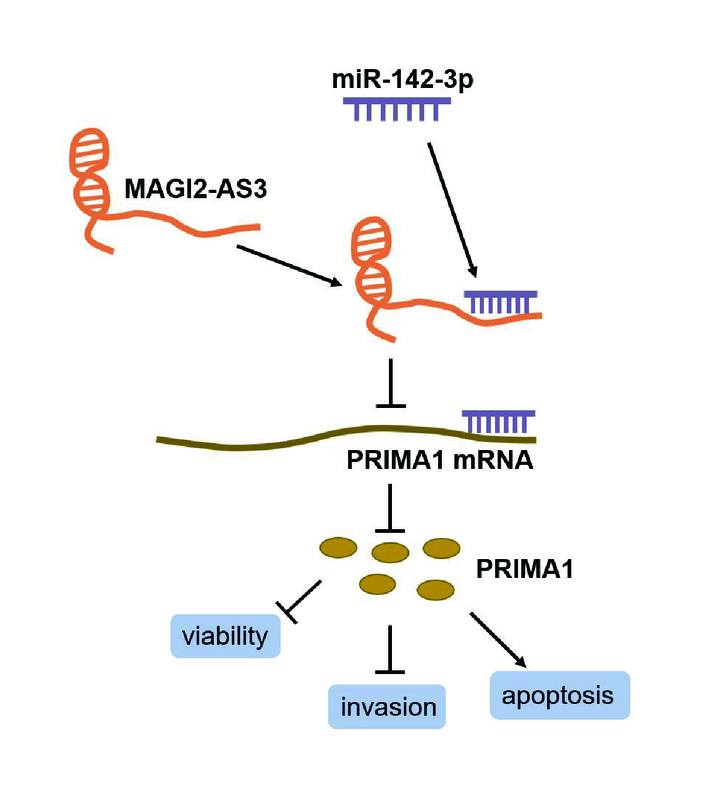Current issue
Archive
Manuscripts accepted
About the Journal
Editorial office
Editorial board
Section Editors
Abstracting and indexing
Subscription
Contact
Ethical standards and procedures
Most read articles
Instructions for authors
Article Processing Charge (APC)
Regulations of paying article processing charge (APC)
UROLOGY / RESEARCH PAPER
MAGI2 antisense RNA 3 (MAGI2-AS3) knockdown contributes to prostate cancer by downregulating proline-rich membrane anchor 1 (PRIMA1) via miR-142-3p
1
Xindu District People's Hospital of Chengdu, China
2
The General Hospital of Western Theater Command of PLA, China
Submission date: 2022-12-29
Final revision date: 2023-05-04
Acceptance date: 2023-06-05
Online publication date: 2023-07-01
KEYWORDS
TOPICS
ABSTRACT
Introduction:
Long non-coding RNA Membrane-Associated Guanylate Kinase Inverted 2 Antisense RNA 3 (MAGI2-AS3) has been identified as a predictive characteristic for prostate cancer (PC). However, the underlying mechanism of MAGI2-AS3 in PC is yet unclear.
Material and methods:
The gene expression was detected via reverse transcription quantitative PCR. Cell viability, apoptosis and invasion were detected via cell counting kit-8, caspase-3 activity, flow cytometry, and transwell assays. Tumor xenograft experiment was performed to measure the tumor growth in vivo. Luciferase and radioimmunoprecipitation assays were utilized to determine the association between microRNA (miR)-142-3p and MAGI2-AS3 or proline-rich membrane anchor 1 (PRIMA1).
Results:
MAGI2-AS3 and PRIMA1 were established to be downregulated in PC, whereas miR-142-3p exhibited the upregulation in PC. In vitro and in vivo loss-of-function assays demonstrated that MAGI2-AS3 silencing increased the viability and invasiveness, enhanced the tumor growth of PC cells, while reducing apoptosis. PRIMA1 silencing in PC cells showed the similar effect as MAGI2-AS3 silencing. Moreover, the miR-142-3p inhibitor reversed the impacts of the downregulation of MAGI2-AS3 or PRIMA1 on the malignant behavior of PC cells.
Conclusions:
MAGI2-AS3 knockdown enhanced the malignant behavior of PC cells by targeting miR-142-3p to suppress PRIMA1 expression. Our findings reveal that MAGI2-AS3 can be a promising therapeutic target for the treatment of PC.
Long non-coding RNA Membrane-Associated Guanylate Kinase Inverted 2 Antisense RNA 3 (MAGI2-AS3) has been identified as a predictive characteristic for prostate cancer (PC). However, the underlying mechanism of MAGI2-AS3 in PC is yet unclear.
Material and methods:
The gene expression was detected via reverse transcription quantitative PCR. Cell viability, apoptosis and invasion were detected via cell counting kit-8, caspase-3 activity, flow cytometry, and transwell assays. Tumor xenograft experiment was performed to measure the tumor growth in vivo. Luciferase and radioimmunoprecipitation assays were utilized to determine the association between microRNA (miR)-142-3p and MAGI2-AS3 or proline-rich membrane anchor 1 (PRIMA1).
Results:
MAGI2-AS3 and PRIMA1 were established to be downregulated in PC, whereas miR-142-3p exhibited the upregulation in PC. In vitro and in vivo loss-of-function assays demonstrated that MAGI2-AS3 silencing increased the viability and invasiveness, enhanced the tumor growth of PC cells, while reducing apoptosis. PRIMA1 silencing in PC cells showed the similar effect as MAGI2-AS3 silencing. Moreover, the miR-142-3p inhibitor reversed the impacts of the downregulation of MAGI2-AS3 or PRIMA1 on the malignant behavior of PC cells.
Conclusions:
MAGI2-AS3 knockdown enhanced the malignant behavior of PC cells by targeting miR-142-3p to suppress PRIMA1 expression. Our findings reveal that MAGI2-AS3 can be a promising therapeutic target for the treatment of PC.
Share
RELATED ARTICLE
We process personal data collected when visiting the website. The function of obtaining information about users and their behavior is carried out by voluntarily entered information in forms and saving cookies in end devices. Data, including cookies, are used to provide services, improve the user experience and to analyze the traffic in accordance with the Privacy policy. Data are also collected and processed by Google Analytics tool (more).
You can change cookies settings in your browser. Restricted use of cookies in the browser configuration may affect some functionalities of the website.
You can change cookies settings in your browser. Restricted use of cookies in the browser configuration may affect some functionalities of the website.



